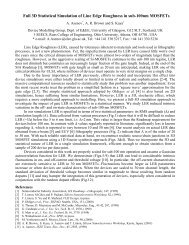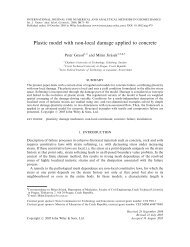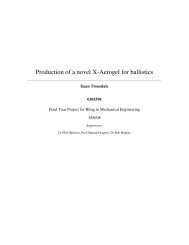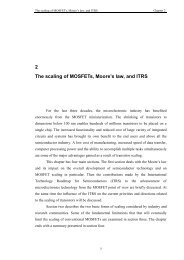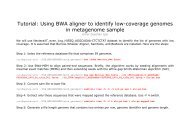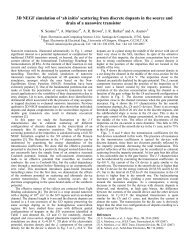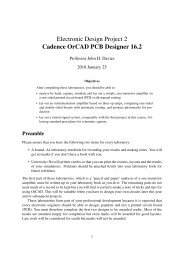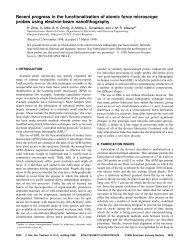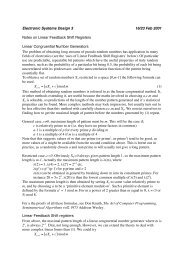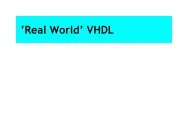Quantum corrections in the simulation of decanano MOSFETs
Quantum corrections in the simulation of decanano MOSFETs
Quantum corrections in the simulation of decanano MOSFETs
Create successful ePaper yourself
Turn your PDF publications into a flip-book with our unique Google optimized e-Paper software.
Solid-State Electronics 47 (2003) 1141–1145www.elsevier.com/locate/sse<strong>Quantum</strong> <strong>corrections</strong> <strong>in</strong> <strong>the</strong> <strong>simulation</strong> <strong>of</strong> <strong>decanano</strong> <strong>MOSFETs</strong>A. Asenov * , A.R. Brown, J.R. Watl<strong>in</strong>gDevice Modell<strong>in</strong>g Group, Department <strong>of</strong> Electronics and Electrical Eng<strong>in</strong>eer<strong>in</strong>g, University <strong>of</strong> Glasgow, G12 8LT Glasgow, Scotland, UKAbstract<strong>Quantum</strong> mechanical conf<strong>in</strong>ement and tunnell<strong>in</strong>g play an important role <strong>in</strong> present and future generation <strong>decanano</strong>(sub-100 nm) <strong>MOSFETs</strong> and have to be properly taken <strong>in</strong>to account <strong>in</strong> <strong>the</strong> <strong>simulation</strong> and design. Here we present asimple approach <strong>of</strong> <strong>in</strong>troduc<strong>in</strong>g quantum <strong>corrections</strong> <strong>in</strong> a 3D drift–diffusion <strong>simulation</strong> framework us<strong>in</strong>g <strong>the</strong> densitygradient (DG) algorithm. We discuss <strong>the</strong> calibration <strong>of</strong> <strong>the</strong> DG approach <strong>in</strong> respect <strong>of</strong> quantum conf<strong>in</strong>ement effects <strong>in</strong>comparison with more comprehensive but computationally expensive quantum <strong>simulation</strong> techniques. We also speculateabout <strong>the</strong> capability <strong>of</strong> DG to describe source-to-dra<strong>in</strong> tunnell<strong>in</strong>g <strong>in</strong> sub-10 nm (nano) MOSFETS. The application<strong>of</strong> <strong>the</strong> DG approach is illustrated with examples <strong>of</strong> 3D statistical <strong>simulation</strong>s <strong>of</strong> <strong>in</strong>tr<strong>in</strong>sic fluctuation effects <strong>in</strong><strong>decanano</strong> and nano-scale double-gate <strong>MOSFETs</strong>.Ó 2003 Elsevier Science Ltd. All rights reserved.1. Introduction<strong>MOSFETs</strong> scaled down to 15 nm gate lengths havebeen successfully demonstrated [1] and 9 nm <strong>MOSFETs</strong>are expected <strong>in</strong> mass production <strong>in</strong> 2016 accord<strong>in</strong>g <strong>the</strong>new edition <strong>of</strong> <strong>the</strong> roadmap. There is a consensus,however, that scal<strong>in</strong>g around and below 10 nm will requirea departure from <strong>the</strong> traditional MOSFET architecture.Among <strong>the</strong> most promis<strong>in</strong>g nanometre scaletransistor candidates are double-gate <strong>MOSFETs</strong> [2].The comb<strong>in</strong>ation <strong>of</strong> th<strong>in</strong> gate oxides and heavy dop<strong>in</strong>g<strong>in</strong> <strong>the</strong> conventional <strong>MOSFETs</strong>, and <strong>the</strong> th<strong>in</strong> siliconbody <strong>of</strong> <strong>the</strong> double-gate structures, will result <strong>in</strong> substantialquantum mechanical (QM) threshold voltageshift and transconductance degradation [3]. Below 10nm gate-lengths direct source-to-dra<strong>in</strong> tunnell<strong>in</strong>g willrapidly became one <strong>of</strong> <strong>the</strong> major limit<strong>in</strong>g factors forscal<strong>in</strong>g [4]. Computationally efficient methods to <strong>in</strong>cludeQM effects are required for <strong>the</strong> purpose <strong>of</strong> practicalcomputer aided design <strong>of</strong> this generation <strong>of</strong> devices.First order quantum <strong>corrections</strong> based on density gradients(DGs) have already been <strong>in</strong>troduced <strong>in</strong> 2-D [5]and 3-D [6] drift–diffusion <strong>simulation</strong>s. In this paper wediscuss <strong>the</strong> implementation <strong>of</strong> DG quantum <strong>corrections</strong>* Correspond<strong>in</strong>g author. Fax: +44-141-330-4907.E-mail address: a.asenov@elec.gla.ac.uk (A. Asenov).<strong>in</strong> a 3-D drift–diffusion <strong>simulation</strong> network designed tostudy <strong>in</strong>tr<strong>in</strong>sic parameter fluctuations <strong>in</strong>troduced by <strong>the</strong>discreteness <strong>of</strong> charge and atomicity <strong>of</strong> matter. We startwith <strong>the</strong> calibration <strong>of</strong> <strong>the</strong> DG approach <strong>in</strong> respect <strong>of</strong>quantum conf<strong>in</strong>ement effects <strong>in</strong> comparison with moresophisticated quantum <strong>simulation</strong>s [2]. We also <strong>in</strong>vestigateto what extent <strong>the</strong> DG approach can describe, atleast semi-quantitatively, <strong>the</strong> expected source-to-dra<strong>in</strong>tunnell<strong>in</strong>g <strong>in</strong> nano-scale devices. F<strong>in</strong>ally we illustrate <strong>the</strong>application <strong>of</strong> DG corrected drift–diffusion <strong>simulation</strong>s<strong>in</strong> <strong>the</strong> analysis <strong>of</strong> various sources <strong>of</strong> <strong>in</strong>tr<strong>in</strong>sic fluctuations<strong>in</strong> <strong>decanano</strong> double-gate <strong>MOSFETs</strong>.2. The density gradient approachWe are motivated by <strong>the</strong> need to <strong>in</strong>clude quantum<strong>corrections</strong> <strong>in</strong> <strong>the</strong> atomistic <strong>simulation</strong> <strong>of</strong> <strong>in</strong>tr<strong>in</strong>sic fluctuationeffects <strong>in</strong> <strong>decanano</strong> <strong>MOSFETs</strong> <strong>in</strong>troduced byatomicity <strong>of</strong> charge and matter [6–8]. The <strong>in</strong>vestigation<strong>of</strong> <strong>in</strong>tr<strong>in</strong>sic fluctuation effects <strong>in</strong>volves statistical 3-D<strong>simulation</strong>s <strong>of</strong> large samples <strong>of</strong> macroscopically identicalbut microscopically different devices and is verycomputationally expensive. Therefore <strong>the</strong> computationalefficiency <strong>of</strong> <strong>the</strong> quantum correction approach is<strong>of</strong> great importance and <strong>the</strong> use <strong>of</strong> <strong>the</strong> DG approachbecomes an attractive option.0038-1101/03/$ - see front matter Ó 2003 Elsevier Science Ltd. All rights reserved.doi:10.1016/S0038-1101(03)00030-3
1142 A. Asenov et al. / Solid-State Electronics 47 (2003) 1141–1145The DG approach may be derived from <strong>the</strong> oneparticle Wigner function [9]:"<strong>of</strong> ðk; r; tÞ2þ v r r f ðk; r; tÞ V ðrÞ s<strong>in</strong>hr ! #r r kf ðk; r; tÞoth 2 <strong>of</strong> ðk; r; tÞ¼ð1Þotcoll<strong>Quantum</strong> effects are <strong>in</strong>cluded through <strong>the</strong> <strong>in</strong>herentlynon-local driv<strong>in</strong>g potential <strong>in</strong> <strong>the</strong> third term on <strong>the</strong> lefthandside. Expand<strong>in</strong>g to first order <strong>in</strong> h, so that only <strong>the</strong>first non-local quantum term is considered, has beenshown to be sufficiently accurate to model non-equilibriumquantum transport and also for <strong>the</strong> <strong>in</strong>clusion <strong>of</strong>tunnell<strong>in</strong>g phenomena <strong>in</strong> particle based Monte Carlosimulators [10,11]. The additional, non-classical, quantumcorrection term may be viewed as a modification to<strong>the</strong> classical potential and acts like an additional quantumforce term <strong>in</strong> <strong>the</strong> particle <strong>simulation</strong>s, similar <strong>in</strong>spirit to <strong>the</strong> Bohm <strong>in</strong>terpretation.The DG approximation may be derived <strong>in</strong> a mannersimilar to that for deriv<strong>in</strong>g <strong>the</strong> drift–diffusion approximationfrom <strong>the</strong> Boltzmann transport equation and results<strong>in</strong> a quantum potential correction term <strong>in</strong> <strong>the</strong>standard drift–diffusion flux [5]. pffiffir 2 nF n ¼ nl n rw D n rn þ 2lr b n pffiffiffið2Þnwhere b n ¼ h=ð12qm nÞ, and all o<strong>the</strong>r symbols have <strong>the</strong>irusual mean<strong>in</strong>g. To avoid <strong>the</strong> discretisation <strong>of</strong> fourthorder derivatives <strong>in</strong> (1) <strong>in</strong> multidimensional numerical<strong>simulation</strong>s a generalised electron quasi-Fermi potential/ n is <strong>in</strong>troduced as follows:F n ¼ nl n r/ nð3ÞThus <strong>the</strong> unipolar drift–diffusion system <strong>of</strong> equationswith QM <strong>corrections</strong>, which <strong>in</strong> many cases is sufficientfor MOSFET <strong>simulation</strong>s, becomes:rðerwÞ ¼ qðp n þ N þ DN AÞ ð4Þpffiffir 2 n2b n pffiffi¼ /n n w þ kT q ln n ð5Þn iFig. 1. Threshold voltage shift due to quantum effects versussubstrate dop<strong>in</strong>g. Results for DG and EP are compared tothose obta<strong>in</strong>ed from PS.<strong>simulation</strong>s. Fig. 1 shows <strong>the</strong> QM threshold voltage shiftfor DG as a function <strong>of</strong> substrate dop<strong>in</strong>g compared with<strong>the</strong> results presented by Jallepalli [2]. Simulation resultsobta<strong>in</strong>ed us<strong>in</strong>g <strong>the</strong> recently developed effective potential(EP) quantum correction approach [12] are also presentedfor comparison <strong>in</strong> this and <strong>the</strong> follow<strong>in</strong>g tw<strong>of</strong>igures. Utilis<strong>in</strong>g a s<strong>in</strong>gle value <strong>of</strong> <strong>the</strong> electron effectivemass <strong>of</strong> 0:18m 0 , obta<strong>in</strong>ed from match<strong>in</strong>g <strong>the</strong> PS resultsat dop<strong>in</strong>g concentration 10 18 cm 3 <strong>the</strong> DG <strong>simulation</strong>sfollow precisely <strong>the</strong> PS results. Fig. 2 shows typicalcarrier concentration pr<strong>of</strong>iles obta<strong>in</strong>ed from <strong>the</strong> 1-D<strong>simulation</strong>s. Both <strong>the</strong> DG and <strong>the</strong> EP <strong>simulation</strong>s showa peak <strong>in</strong> <strong>the</strong> concentration away from <strong>the</strong> Si/SiO 2 <strong>in</strong>terface,although <strong>the</strong> EP produces a sharper drop-<strong>of</strong>f at<strong>the</strong> Si/SiO 2 <strong>in</strong>terface compared to PS and DG.Fig. 3, shows an I D –V G characteristic for a 30 nm · 30nm n-MOSFET obta<strong>in</strong>ed from our 3-D quantum sim-rðnl n r/ n Þ¼0ð6ÞThe system <strong>of</strong> equations (4)–(6) is solved self-consistentlyus<strong>in</strong>g standard techniques.3. CalibrationWe have carefully calibrated <strong>the</strong> DG approachaga<strong>in</strong>st <strong>the</strong> results <strong>of</strong> a full-band 1-D Poisson–Schr€od<strong>in</strong>ger (PS) solver [2]. Although PS <strong>simulation</strong>s aremore accurate <strong>the</strong>y are not yet practical for 3-D deviceFig. 2. Electron carrier concentration as a function <strong>of</strong> distancefrom <strong>the</strong> <strong>in</strong>terface, for substrate dop<strong>in</strong>g <strong>of</strong> 5 · 10 17 cm 3 . Allhave <strong>the</strong> same net sheet density.
A. Asenov et al. / Solid-State Electronics 47 (2003) 1141–1145 1143Fig. 3. I D –V G characteristic obta<strong>in</strong>ed from both classical andquantum simulators for a 30 nm 30 nm n-MOSFET, withV D ¼ 0:01 V and a substrate dop<strong>in</strong>g <strong>of</strong> 5 10 18 cm 3 .Fig. 5. <strong>Quantum</strong> (DG) electron concentration pr<strong>of</strong>ile through<strong>the</strong> centre <strong>of</strong> a 30 30 1.5 nm double-gate MOSFET. Theoxide thickness is 1.5 nm.ulator. The threshold voltage shift between <strong>the</strong> classicaland <strong>the</strong> quantum <strong>simulation</strong>s and <strong>the</strong> overall shape <strong>of</strong><strong>the</strong> current–voltage characteristics obta<strong>in</strong>ed us<strong>in</strong>g <strong>the</strong>DG and EP approaches are very similar.4. Source-to-dra<strong>in</strong> tunnell<strong>in</strong>gIt still rema<strong>in</strong>s unclear to what extent <strong>the</strong> approximations<strong>in</strong>volved <strong>in</strong> deriv<strong>in</strong>g <strong>the</strong> DG approach removeits ability to model <strong>the</strong> direct source-to-dra<strong>in</strong> tunnell<strong>in</strong>gexpected <strong>in</strong> nanometre channel length <strong>MOSFETs</strong>. Insearch <strong>of</strong> a qualitative answer to this question we simulatea set <strong>of</strong> double-gate <strong>MOSFETs</strong> with genericstructure illustrated <strong>in</strong> Fig. 4.Fig. 5 shows <strong>the</strong> electron concentration distributionnormal to <strong>the</strong> gate obta<strong>in</strong>ed from <strong>the</strong> DG <strong>simulation</strong>s <strong>of</strong>a30 30 1.5 nm double-gate MOSFET. As expected,for such a th<strong>in</strong> Si body quantum conf<strong>in</strong>ement effectsproduce a peak <strong>in</strong> <strong>the</strong> distribution <strong>in</strong> <strong>the</strong> middle <strong>of</strong> <strong>the</strong>channel.Fig. 6 illustrates <strong>the</strong> current–voltage characteristicsfor a set <strong>of</strong> double-gate transistors with channel lengthsFig. 4. Schematic representation <strong>of</strong> <strong>the</strong> double-gate <strong>MOSFETs</strong>tructure considered <strong>in</strong> this work.Fig. 6. I D –V G characteristics for a double-gate structure, withgate lengths rang<strong>in</strong>g from 30 down to 6 nm, obta<strong>in</strong>ed from ourclassical and DG <strong>simulation</strong>s. V D ¼ 0:01 V and V G is applied toboth top and bottom gate contacts.<strong>in</strong> <strong>the</strong> range from 30 to 6 nm. In <strong>the</strong> DG <strong>simulation</strong>s <strong>the</strong>sub-threshold slope degrades significantly as <strong>the</strong> channellength is decreased, while <strong>in</strong> <strong>the</strong> classical <strong>simulation</strong>s <strong>the</strong>sub-threshold slope rema<strong>in</strong>s nearly constant with channellength. The degradation <strong>in</strong> <strong>the</strong> sub-threshold slope <strong>in</strong><strong>the</strong> DG <strong>simulation</strong>s is consistent with <strong>the</strong> more elaborateQM <strong>simulation</strong>s performed by o<strong>the</strong>rs [13]. These observationsprovide an <strong>in</strong>dication that source-to-dra<strong>in</strong>tunnell<strong>in</strong>g is <strong>in</strong>cluded, to some extent, <strong>in</strong> <strong>the</strong> DG <strong>simulation</strong>s.Fur<strong>the</strong>r evidence can be ga<strong>in</strong>ed by look<strong>in</strong>g at <strong>the</strong>temperature dependence <strong>of</strong> <strong>the</strong> sub-threshold slope illustrated<strong>in</strong> Fig. 7. In <strong>the</strong> classical drift–diffusion <strong>simulation</strong>s<strong>the</strong> sub-threshold slope, essentially <strong>the</strong>rmionic <strong>in</strong>nature, depends l<strong>in</strong>early on temperature. However, anycurrent due to tunnell<strong>in</strong>g will have a much weakertemperature dependence [14].
1144 A. Asenov et al. / Solid-State Electronics 47 (2003) 1141–1145Fig. 9. Electron equiconcentration surface <strong>in</strong> a 30 30 5nmdouble-gate atomistic MOSFET with location <strong>of</strong> dopantsshown.Fig. 7. I D –V G characteristics for an 8 nm channel length doublegatestructure from classical and DG <strong>simulation</strong>s, for a range <strong>of</strong>temperatures. V D ¼ 0:01 V and V G is applied to both top andbottom gate contacts.5. Random discrete dopantsTheoretically <strong>the</strong> double-gate <strong>MOSFETs</strong> do not requirechannel dop<strong>in</strong>g to operate and <strong>the</strong>refore are consideredto be <strong>in</strong>herently resistant to random dopant<strong>in</strong>duced parameter fluctuations. Here we <strong>in</strong>vestigate towhat extent <strong>the</strong> random dopants <strong>in</strong> <strong>the</strong> source and dra<strong>in</strong>region <strong>in</strong>troduce <strong>in</strong>tr<strong>in</strong>sic parameter fluctuations <strong>in</strong> suchdevices.Figs. 8 and 9 illustrate <strong>the</strong> impact <strong>of</strong> <strong>the</strong> unavoidablediscrete dopants <strong>in</strong> <strong>the</strong> source/dra<strong>in</strong> region on <strong>the</strong> potentialand <strong>the</strong> electron distribution <strong>in</strong> a 30 30 5nmdouble-gate MOSFET. The carrier concentration <strong>in</strong> <strong>the</strong>source and dra<strong>in</strong> region is modulated by <strong>the</strong> potentialfluctuations associated with <strong>in</strong>dividual discrete dopants.The maximum <strong>in</strong> <strong>the</strong> carrier concentration is <strong>in</strong> <strong>the</strong>middle <strong>of</strong> <strong>the</strong> channel.As shown <strong>in</strong> Table 1 <strong>the</strong> correspond<strong>in</strong>g effectivechannel length fluctuations <strong>in</strong>troduce small thresholdvoltage fluctuations which <strong>in</strong>crease from 0.66 to 1.07 mVas <strong>the</strong> device is scaled from 30 to 10 nm. The on-statecurrent, however, does exhibit significant fluctuations,particularly for <strong>the</strong> shorter channel length device. This isassociated with <strong>the</strong> effective channel length variationFig. 8. Electrostatic potential <strong>in</strong> a 30 30 5 nm double-gateatomistic MOSFET at threshold.Table 1Intr<strong>in</strong>sic parameter fluctuations <strong>in</strong> 10 and 30 nm double-gate<strong>MOSFETs</strong> due to atomistic dop<strong>in</strong>g <strong>in</strong> <strong>the</strong> source and dra<strong>in</strong>Channeldimensions(L W T )[nm]along <strong>the</strong> channel <strong>in</strong>troduced by <strong>the</strong> random discretedopant distribution <strong>in</strong> <strong>the</strong> source and <strong>the</strong> dra<strong>in</strong> regions.6. ConclusionsThe DG approach provides computationally efficientmeans for <strong>in</strong>corporat<strong>in</strong>g quantum <strong>corrections</strong> <strong>in</strong> multidimensionaldevice <strong>simulation</strong>s. It agrees well with <strong>the</strong>available data from PS <strong>simulation</strong>s. In <strong>the</strong> <strong>simulation</strong> <strong>of</strong>sub-10 nm double-gate <strong>MOSFETs</strong> <strong>the</strong> DG approachshows behaviour qualitatively consistent with sourceto-dra<strong>in</strong>tunnell<strong>in</strong>g.ReferencesThresholdvoltagefluctuationsrV T [mV]Off-currentfluctuationsrI D [%]10 30 1.5 1.07 9.56 7.1330 30 5 0.66 3.28 1.93The threshold voltage is 200 mV.On-currentfluctuationsrI D [%][1] Thompson S, Alavi M, Argavani R, Brand A, Bigwood R,Brandenburg J, et al. IEDM Tech Digest 2001:257–61.[2] Hisamoto D. IEDM Tech Digest 2001:429–32.[3] Jallepalli S, Bude J, Shih WK, P<strong>in</strong>to MR, Maziar CM,Tasch Jr AF. IEEE Trans Electron Dev 1997;44:297–303.[4] Ren Z, Venugopal R, Datta S, Lundstrom M, JovanovicD, Fossum J. IEDM Tech Digest 2001:107–10.[5] Rafferty CS, Biegel B, Yu Z, Ancona MG, Bude J, DuttonRW. In: De Meyer, Biesemans, editors. SISPADÕ98; 1998.p. 137–40.[6] Asenov A, Slavcheva G, Brown AR, Davies JH, Sa<strong>in</strong>i S.IEDM Tech Digest 1999:535–8.[7] Asenov A, Kaya S, Davies JH. IEEE Trans Electron Dev2002;49:112–9.[8] Asenov A, Slavcheva G, Brown AR, Davies JH, Sa<strong>in</strong>i S.IEEE Trans Electron Dev 2001;48:722–9.
A. Asenov et al. / Solid-State Electronics 47 (2003) 1141–1145 1145[9] Carru<strong>the</strong>rs P, Zachariasen F. Rev Modern Phys 1983;55:245–84.[10] Tsuchiya H, Fischer B, Hess K. IEDM Tech Digest 2000:283–6.[11] Tsuchiya H, Miyoshi T. Superlattices Microstruct 2000;27:529–32.[12] Ferry DK, Akis R, Vasileska D. IEDM Tech Digest 2000:287–90.[13] Lundstrom M. Private communication, June 2001.[14] Kawaura H, Sakamoto T, Baba T, Ochiai Y, Fujita J, SoneJ. IEEE Trans Electron Dev 2000;47:856–60.



